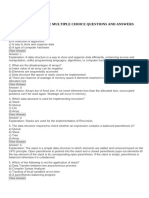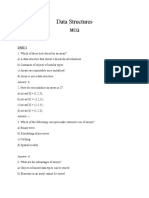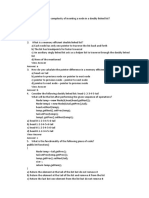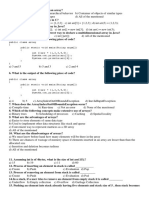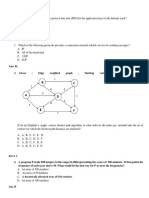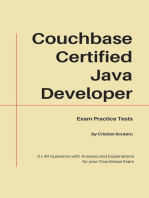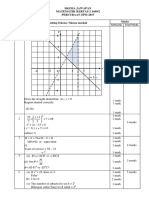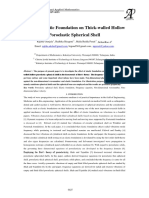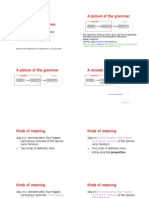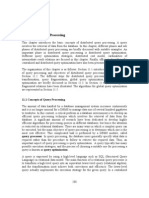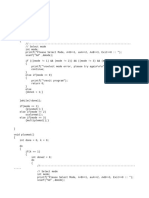Quiz4 Sol PDF
Quiz4 Sol PDF
Uploaded by
Piyush JindalCopyright:
Available Formats
Quiz4 Sol PDF
Quiz4 Sol PDF
Uploaded by
Piyush JindalOriginal Description:
Original Title
Copyright
Available Formats
Share this document
Did you find this document useful?
Is this content inappropriate?
Copyright:
Available Formats
Quiz4 Sol PDF
Quiz4 Sol PDF
Uploaded by
Piyush JindalCopyright:
Available Formats
EECS 211: FUNDAMENTALS OF COMPUTER PROGRAMMING II
Quiz 4 Solutions
Q1: What value does function mystery return when called with a value of 4? int mystery ( int number ) { if ( number <= 1 ) return 1; else return number * mystery( number 1 ); } a. 0. b. 1. c. 4. d. 24. ANS: d. 24.
Q2: Recursion is memory-intensive because: a. Recursive functions tend to declare many local variables. b. Previous function calls are still open when the function calls itself and the activation records of these previous calls still occupy space on the call stack. c. Many copies of the function code are created. d. It requires large data values. ANS: b. Previous function calls are still open when the function calls itself and the activation records of these previous calls still occupy space on the call stack.
Q3: Linear search is highly inefficient compared to binary search when dealing with: a. Small, unsorted arrays. b. Small, sorted arrays. c. Large, unsorted arrays. d. Large, sorted arrays. ANS: d. Large, sorted arrays.
Q4: A double subscripted array declared as int a[ 3 ][ 5 ]; has how many elements? a. 15 b. 13 c. 10 d. 8 ANS: a. 15
1|Quiz 4 Solutions
EECS 211: FUNDAMENTALS OF COMPUTER PROGRAMMING II
Q5: Using square brackets ([]) to retrieve vector elements __________ perform bounds checking; using member function at to retrieve vector elements __________ perform bounds checking. a. Does not, does not. b. Does not, does. c. Does, does not. d. Does, does. ANS: b. Does not, does.
Q6: Which file open mode would be used to write data only to the end of an existing file? a. ios::app b. ios::in c. ios::out d. ios::trunc ANS a. ios::app
Q7: A random access file is organized most like a(n): a. Array. b. Object. c. Class. d. Pointer. ANS: a. Array.
Q8: To write fixed-length records, use file open mode: a. ios::app b. ios::ate c. ios::trunc d. ios::binary ANS: d. ios::binary
Q9: The total number of elements that can be stored in a string without increasing its current amount of allocated memory is called its: a. Size. b. Length. c. Capacity. d. Maximum size. ANS: c. Capacity.
Q10: An algorithm that requires __________ operations to complete its task on n data elements is said to have a linear runtime. 3 a. n + 9 2 b. 3 n + 3 n + 2 c. 2 n + 1 d. 6 ANS c. 2 n + 1
2|Quiz 4 Solutions
EECS 211: FUNDAMENTALS OF COMPUTER PROGRAMMING II
Q11: At most, how many comparisons are required to search a sorted vector of 1023 elements using the binary search algorithm? a. 10 b. 15 c. 20 d. 30 ANS a. 10
Q12: Which of the following represents the efficiency of the insertion sort? a. O(1) b. O(log n) c. O(n) d. O(n2) ANS: d. O(n2)
Q13: Which of the following is not a dynamic data structure? a. Linked list. b. Stack. c. Array. d. Binary tree. ANS c. Array.
Q14: In general, linked lists allow: a. Insertions and removals anywhere. b. Insertions and removals only at one end. c. Insertions at the back and removals from the front. d. None of the above. ANS a. Insertions and removals anywhere.
Q15: Which data structure represents a waiting line and limits insertions to be made at the back of the data structure and limits removals to be made from the front? a. Stack. b. Queue. c. Binary tree. d. Linked list. ANS b. Queue.
Q16: Given that the line delete newPtr; just executed, what can you conclude? a. The memory referenced by newPtr is released only if it is needed by the system. b. The pointer newPtr is of type void *. c. The pointer newPtr only exists if there was an error freeing the memory. d. The pointer newPtr still exists. ANS d. The pointer newPtr still exists.
3|Quiz 4 Solutions
EECS 211: FUNDAMENTALS OF COMPUTER PROGRAMMING II
Q17: What kind of linked list begins with a pointer to the first node, and each node contains a pointer to the next node, and the pointer in the last node points back to the first node? a. Circular, singly-linked list. b. Circular, doubly-linked list. c. Singly-linked list. d. Doubly-linked list. ANS a. Circular, singly-linked list.
Q18: How many pointers are contained as data members in the nodes of a circular, doubly linked list of integers with five nodes? a. 5 b. 8 c. 10 d. 15 ANS c. 10
Q19: Which of the following statements about stacks is incorrect? a. Stacks can be implemented using linked lists. b. Stacks are first-in, first-out (FIFO) data structures. c. New nodes can only be added to the top of the stack . d. The last node (at the bottom) of a stack has a null (0) link. ANS b. Stacks are first-in, first-out (FIFO) data structures.
Q20: Select the incorrect statement. Binary search trees (regardless of the order in which the values are inserted into the tree): a. Always have multiple links per node. b. Can be sorted efficiently. c. Always have the same shape for a particular set of data. d. Are nonlinear data structures. ANS: c. Always have the same shape for a particular set of data .
Q21: Which of the following is not a sequence container provided by the STL? a. vector b. array c. list d. deque ANS: b. array
Q22: Which of the following is a difference between vectors and arrays? a. Access to any element using the [] operator. b. Stored in contiguous blocks of memory. c. The ability to change size dynamically. d. Efficient direct access to any element. ANS: c. The ability to change size dynamically.
4|Quiz 4 Solutions
EECS 211: FUNDAMENTALS OF COMPUTER PROGRAMMING II
The next 3 questions are about the speaker and talk from May 10th which you were asked to attend. Q23: What was the name of the speaker? a. Peter Dinda b. Ian Foster c. Alok Choudhary d. Bob Grossman ANS: b. Ian Foster
Q24: (2 points) What is the one word that describes Grid? a. Distributed b. Federation c. Computing d. Cloud ANS: b. Federation
Q25: (2 points) What relationship does the speaker have with the instructor? a. He is his professor. b. He doesn't know him personally. c. He is his PhD advisor. d. He is a relative. ANS: c. He is his PhD advisor or a. He is his professor.
5|Quiz 4 Solutions
You might also like
- Mathematical Reasoning Practice Test Yr 7Document8 pagesMathematical Reasoning Practice Test Yr 7mv100% (3)
- Slotted Link MechanismDocument6 pagesSlotted Link MechanismShawn Waltz50% (2)
- Myp Eassessment October 2013 Trial Mathematics: (50 Marks Max)Document19 pagesMyp Eassessment October 2013 Trial Mathematics: (50 Marks Max)uwu100% (3)
- Fundamentals of Data Structures - MCQ - III.Document22 pagesFundamentals of Data Structures - MCQ - III.Jeya Perumal100% (1)
- Data Structure and Algorithm MCQsDocument9 pagesData Structure and Algorithm MCQssaddambaloch309No ratings yet
- Data Structure MCQ (Multiple Choice Questions) - SanfoundryDocument15 pagesData Structure MCQ (Multiple Choice Questions) - SanfoundryEzekiel JamesNo ratings yet
- DS Combined All UnitsDocument66 pagesDS Combined All Units30. Suraj IngaleNo ratings yet
- Data Structure Multiple Choice Questions and AnswersDocument97 pagesData Structure Multiple Choice Questions and AnswersIT sacwcNo ratings yet
- DataStructure End Sem Lab Eam EEDocument8 pagesDataStructure End Sem Lab Eam EEDivyanshu Bose50% (2)
- Data StructureDocument11 pagesData Structuresumrun sahabNo ratings yet
- Data-Structures (Set 1)Document21 pagesData-Structures (Set 1)Surya ANo ratings yet
- Data Structure Mcqs Single FileDocument28 pagesData Structure Mcqs Single Filemuhammadashiqk100No ratings yet
- BCA-2Sem Data StructureDocument30 pagesBCA-2Sem Data StructureSHAMBHU JHANo ratings yet
- QUEUEDocument5 pagesQUEUEMohammadMoizNo ratings yet
- Public Class Array (Public Static Void Main (String Args ) (Int Arr (1,2,3,4,5) System - Out.println (Arr (2) ) System - Out.println (Arr (4) ) ) )Document5 pagesPublic Class Array (Public Static Void Main (String Args ) (Int Arr (1,2,3,4,5) System - Out.println (Arr (2) ) System - Out.println (Arr (4) ) ) )Ash KNo ratings yet
- Unit 1 MCQDocument10 pagesUnit 1 MCQ30. Suraj IngaleNo ratings yet
- Sree Saraswathi Thyagaraja College (Autonomous), PollachiDocument19 pagesSree Saraswathi Thyagaraja College (Autonomous), PollachiElamparithi ManiezhilanNo ratings yet
- TechDocument6 pagesTechkushwah_770145566No ratings yet
- HW 2Document4 pagesHW 2OsamaNo ratings yet
- Question Bank - Data StructuresDocument7 pagesQuestion Bank - Data StructuresRehan PathanNo ratings yet
- Data Structure MCQ QuestionsDocument12 pagesData Structure MCQ QuestionsbhuvneshNo ratings yet
- Dsa NotesDocument27 pagesDsa NotesSameer KhanNo ratings yet
- Quiz DsaDocument18 pagesQuiz Dsalyminh194No ratings yet
- CS301 Grand Quiz PreparationDocument12 pagesCS301 Grand Quiz Preparationflowerrryqueen987No ratings yet
- Data Strucuture McqsDocument8 pagesData Strucuture McqsDr ManiNo ratings yet
- Data StructuresMCQDocument28 pagesData StructuresMCQMinu Choudhary100% (7)
- PIC Unit4 MCQDocument8 pagesPIC Unit4 MCQSaquibh ShaikhNo ratings yet
- cs301 QuizDocument52 pagescs301 QuizHunzala AhmadNo ratings yet
- Combined Bank: Cloud IT Solution MCQDocument23 pagesCombined Bank: Cloud IT Solution MCQSakib MuhaiminNo ratings yet
- FdsallDocument974 pagesFdsallamazon liteshopNo ratings yet
- Data StructureDocument6 pagesData StructureNikhil SabaleNo ratings yet
- Quiz QuestionsDocument2 pagesQuiz QuestionsHimanshu AggarwalNo ratings yet
- 1 ST 2 ND AnsDocument17 pages1 ST 2 ND Ansryansresearch18No ratings yet
- MCQs On Data Structures and AlgorithmsDocument28 pagesMCQs On Data Structures and AlgorithmsProkash BarmanNo ratings yet
- DS CCEE Practice with-ANSDocument7 pagesDS CCEE Practice with-ANSSaurav SanapNo ratings yet
- Computer2010Document17 pagesComputer2010ViJaY HaLdErNo ratings yet
- DL MCQDocument13 pagesDL MCQVinayak PhutaneNo ratings yet
- ComputerDocument27 pagesComputersalimpathan1216No ratings yet
- Linklist MCQDocument6 pagesLinklist MCQDeepa V.VNo ratings yet
- Data StructuresDocument13 pagesData StructuresAyan HaqueNo ratings yet
- Q1: Choose The Correct AnswerDocument15 pagesQ1: Choose The Correct AnswerMohammed ShannenNo ratings yet
- Final Info2206 en 2022-2023.vers1Document10 pagesFinal Info2206 en 2022-2023.vers1alinoureddin313No ratings yet
- CS301 Midterm MCQs by Talha SajidDocument62 pagesCS301 Midterm MCQs by Talha Sajidkatherinekhan185No ratings yet
- SET 2 Ans KeyDocument21 pagesSET 2 Ans KeysomarshidubeyNo ratings yet
- Data Struct FinalDocument21 pagesData Struct FinallathaNo ratings yet
- Day-3 (6.8.2018)Document10 pagesDay-3 (6.8.2018)Surya PrakashNo ratings yet
- Dsa (10-8-2012)Document11 pagesDsa (10-8-2012)HenryHai NguyenNo ratings yet
- Syllabus For Amcat Programming Questions: Topic SubtopicsDocument10 pagesSyllabus For Amcat Programming Questions: Topic SubtopicsSanchit GuptaNo ratings yet
- Chennai Institute of Technology Sarathy Nagar, Pudupedu, Chennai - 600 069. Multiple Choice QuestionsDocument14 pagesChennai Institute of Technology Sarathy Nagar, Pudupedu, Chennai - 600 069. Multiple Choice Questionssureshvk.20087147No ratings yet
- MCQ's On ArrayDocument9 pagesMCQ's On Arrayprathamesh patilNo ratings yet
- Questions 1 Through 25 Are Worth 2 Points Each. Choose One Best Answer For EachDocument5 pagesQuestions 1 Through 25 Are Worth 2 Points Each. Choose One Best Answer For EachThao NguyenNo ratings yet
- Final Info2206 en 2022-2023.vers2Document10 pagesFinal Info2206 en 2022-2023.vers2alinoureddin313No ratings yet
- 5year PDFDocument17 pages5year PDFAnoopNo ratings yet
- C Programming: Cloud IT Online Practices ProblemDocument24 pagesC Programming: Cloud IT Online Practices Problemsilvia emtiazNo ratings yet
- Unit 2 MCQDocument14 pagesUnit 2 MCQ30. Suraj Ingale100% (1)
- Technical Question Bank: Computer ScienceDocument14 pagesTechnical Question Bank: Computer ScienceUttam SinghNo ratings yet
- Year 12 - Data Structures TestDocument4 pagesYear 12 - Data Structures Testvegaand72No ratings yet
- Data StructureDocument13 pagesData StructureAizazAzizNo ratings yet
- Flipkart Grid 6.0 Previous Year Questions FinaldocxDocument34 pagesFlipkart Grid 6.0 Previous Year Questions FinaldocxPatel Devam Rajendrakumar (B22CH021)No ratings yet
- Data Structure and Algorithm Objective Questio1Document3 pagesData Structure and Algorithm Objective Questio1avnesh joshiNo ratings yet
- Advanced C Concepts and Programming: First EditionFrom EverandAdvanced C Concepts and Programming: First EditionRating: 3 out of 5 stars3/5 (1)
- The Self-Taught Computer Scientist: The Beginner's Guide to Data Structures & AlgorithmsFrom EverandThe Self-Taught Computer Scientist: The Beginner's Guide to Data Structures & AlgorithmsNo ratings yet
- Ismaykim1 PDFDocument522 pagesIsmaykim1 PDFchakachakaNo ratings yet
- JPNS MM K2 Set 1 Skema PDFDocument8 pagesJPNS MM K2 Set 1 Skema PDFafzalienaNo ratings yet
- Tuto 2 - Muhammad Najmi Bin KamarudinDocument18 pagesTuto 2 - Muhammad Najmi Bin KamarudinAzlan Abdul Rahim IINo ratings yet
- Top CAT Averages Questions (PDF)Document19 pagesTop CAT Averages Questions (PDF)ritabhola0902No ratings yet
- Pipeline Route DesignDocument36 pagesPipeline Route DesignRichard Yentumi0% (1)
- Fortran 90 TutorialDocument274 pagesFortran 90 TutorialRizal ArifinNo ratings yet
- Effect of Elastic Foundation On Thick-Walled Hollow Poroelastic Spherical ShellDocument10 pagesEffect of Elastic Foundation On Thick-Walled Hollow Poroelastic Spherical ShellNanda KumarNo ratings yet
- Shlok - Infosys HR AssignmentDocument3 pagesShlok - Infosys HR AssignmentShlokNo ratings yet
- Pre-Processing: Bageshree V. Sathe-Pathak, Ashish R. PanatDocument4 pagesPre-Processing: Bageshree V. Sathe-Pathak, Ashish R. PanatRukmani DeviNo ratings yet
- Operations of Polynomials - Addition Subtraction Multiplication and Division of PolynomialsDocument40 pagesOperations of Polynomials - Addition Subtraction Multiplication and Division of PolynomialsKen Aisa G. OrtizNo ratings yet
- BA InnovationDocument11 pagesBA InnovationSandeep DhupalNo ratings yet
- 190 Anos Do Ciclo de Carnot: June 2014Document6 pages190 Anos Do Ciclo de Carnot: June 2014cleytonco2211No ratings yet
- Elitmus 2021 Aptitude Questions With Explanation: For More Materials Join Placement Fellas On Telegram (Click Here)Document8 pagesElitmus 2021 Aptitude Questions With Explanation: For More Materials Join Placement Fellas On Telegram (Click Here)MAHESH VNo ratings yet
- Oikonomia Oikos NemeinDocument2 pagesOikonomia Oikos NemeinCarmel UmandapNo ratings yet
- Sense and ReferenceDocument10 pagesSense and ReferenceRonald ChuiNo ratings yet
- (VVI) Computational Biomechanics For Medicine - Fundamental Science and Patient-Specific ApplicationsDocument128 pages(VVI) Computational Biomechanics For Medicine - Fundamental Science and Patient-Specific Applicationsrehena mojammelNo ratings yet
- Comp AppDocument101 pagesComp AppRamon Villanueva Jr.No ratings yet
- Errors and MistakesDocument15 pagesErrors and MistakesUlan JavierNo ratings yet
- Compare DFS & BFS Graph TraversalsDocument6 pagesCompare DFS & BFS Graph TraversalsKartheeswari SaravananNo ratings yet
- Distributed Database Management Notes - 3Document48 pagesDistributed Database Management Notes - 3Saurav Kataruka86% (7)
- Communication Theory Overall Question BankDocument7 pagesCommunication Theory Overall Question BankECEOCETNo ratings yet
- Mathematics: Quarter 2 - Module 10 Solving Problems Involving RadicalsDocument22 pagesMathematics: Quarter 2 - Module 10 Solving Problems Involving RadicalsFriday SaturdayNo ratings yet
- HausmanDocument3 pagesHausmanTubagus Ajie RahmansyahNo ratings yet
- Correlation Stats Example Jan.7Document21 pagesCorrelation Stats Example Jan.7Eunice OrtileNo ratings yet
- 05-Bar Element DuzeltilmisDocument56 pages05-Bar Element Duzeltilmismmk111No ratings yet
- Modelos Probabilísticos IIND-2104 Universidad de Los Andes 2019-IDocument6 pagesModelos Probabilísticos IIND-2104 Universidad de Los Andes 2019-IJuan Felipe SolorzanoNo ratings yet
- Lab5 3Document6 pagesLab5 3Chawanakorn WoraphanNo ratings yet







